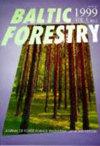拉脱维亚ICP森林监测点苏格兰松林健康趋势和元素流动变化
IF 0.6
4区 农林科学
Q3 FORESTRY
引用次数: 3
摘要
苏格兰松(Pinus sylvestris L.)是拉脱维亚最广泛和最重要的经济树种之一。在评估和监测空气污染对森林的影响国际合作方案(ICP Forests)范围内,拉脱维亚监测了松林健康和元素流动的变化,并在115个一级监测点(主要是少营养型和中营养型Vacciniosa)评估了树冠状况和破坏剂;Myrtillosa和Hylocomiosa森林),并在代表拉脱维亚半北方条件下典型苏格兰松林(Myrtillosa)的三个二级监测点对环境样本进行采样和分析。本研究总结了背景资料,提出了2009年以来苏格兰松林森林健康、碳周转和环境状况的变化趋势。总体而言,在研究期间,苏格兰松林的落叶率保持稳定,每年有一些波动,可能与区域虫害暴发有关,特别是在两个二级样地得到了很好的证明。受损树木的比例逐年变化,从12.8%到19%不等;破坏的主要原因是人的直接行为。二级监测样地苏格兰松林的化学元素流动也相对稳定,但沉积物中总氮浓度和土壤溶液中SO4-S浓度呈下降趋势,土壤溶液中DOC浓度呈上升趋势,与欧洲的共同趋势一致。全期地上凋落物的碳输入相对稳定;然而,年际变化相当大。本文章由计算机程序翻译,如有差异,请以英文原文为准。
Trends of Scots pine forest health and element flow changes in the ICP Forests monitoring sites in Latvia
Scots pine (Pinus sylvestris L.) is one of the most widespread and economically most important tree species in Latvia. Scots pine forest health and element flow changes have been monitored in Latvia within the International Cooperative Programme on Assessment and Monitoring of Air Pollution Effects on Forests (ICP Forests) with assessment of crown condition and damaging agents at 115 Level I monitoring sites (mostly oligothrophic and mesotrophic Vacciniosa, Myrtillosa and Hylocomiosa forests) and with sampling and analyses of environmental samples at three Level II monitoring sites representing typical Scots pine forests (Myrtillosa) in hemiboreal conditions in Latvia. This study summarizes the background information and presents the trends of forest health, carbon turnover and environment condition in Scots pine forest since 2009. In general, defoliation rate in Scots pine stands remains stable for the studied period, with some yearly fluctuations, possibly related to regional insect outbreaks, especially well demonstrated in two Level II plots. The share of damaged trees varied by year from 12.8% to 19% of the total number; the main cause of damage was direct action of man. Chemical element flows in Scots pine forests in Level II monitoring plots have been relatively stable as well except the decreasing trend in total N concentration in deposition and SO4-S concentration in soil solution and increasing trends in DOC concentration in soil solution that is in line with common trends in Europe. Carbon input with above-ground litter was relatively stable during the whole period; however, interannual variations were rather wide.
求助全文
通过发布文献求助,成功后即可免费获取论文全文。
去求助
来源期刊

Baltic Forestry
农林科学-林学
CiteScore
1.60
自引率
0.00%
发文量
23
审稿时长
>12 weeks
期刊介绍:
The journal welcomes the original articles as well as short reports, review papers on forestry and forest science throughout the Baltic Sea region and elsewhere in the area of boreal and temperate forests. The Baltic Sea region is rather unique through its intrinsic environment and distinguished geographical and social conditions. A temperate climate, transitional and continental, has influenced formation of the mixed coniferous and deciduous stands of high productivity and biological diversity. The forest science has been affected by the ideas from both the East and West.
In 1995, Forest Research Institutes and Universities from Estonia, Latvia and Lithuania
joined their efforts to publish BALTIC FORESTRY.
 求助内容:
求助内容: 应助结果提醒方式:
应助结果提醒方式:


